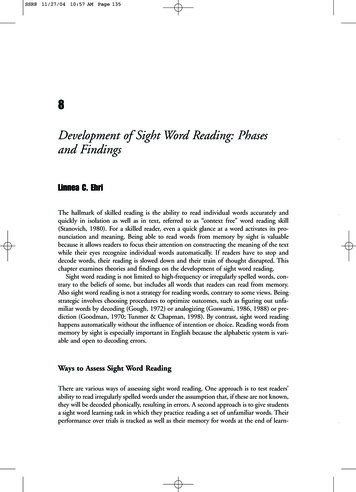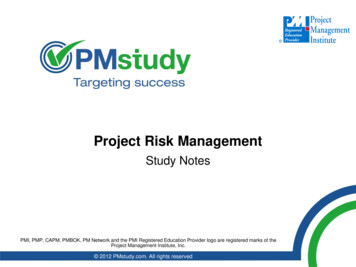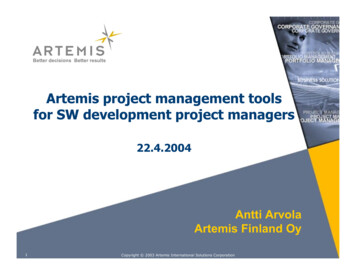
Transcription
Risk Management – All Project PhasesPurpose of Risk Management:Risk management is one of the primary knowledge areas of project management to be appliedthroughout the lifecycle of projects. Project Management Institute (PMI) defines project risk as:Risk management occurs at both project and portfolio levels. This document focuses primarily onproject level risk.“an uncertain event or condition that, if it occurs, has a positive or negative effecton a project’s objectives”.For ODOT, “risk” means more specifically: The potential for positive or negative impacts to scope, schedule, budget or quality (somerisks can be opportunities) Things that are not part of our base assumptions or have not been realized Things that are in our control and influence vs. what’s outside our control and influence Lifecycle flow from planning through maintenanceThe key steps to Risk Management are:1. Identification – what are the potential risks?2. Assessment of probability – what is the likelihood of risk occurrence?3. Decision-making – what strategy is needed to manage each risk?a. Avoidance/Elimination – get rid of itb. Mitigation – take steps to reduce/minimizec. Transfer – move risk to another entity such as a consultant or contractord. Acceptance – absorb the risk and build contingency plan, and adjust the budget and/or scheduleaccordingly4. Monitoring – what is occurring in terms of risk?Documentation of identified risks, risk assessment, decisions made and outcomes is needed throughout the life of theproject to inform each phase. Managing our risks deliberately, consistently and proactively, ODOT can more consistentlyreduce overall project risks to acceptable levels and increase our capacity to eliminate or reduce the impacts of somethreats and capitalize on opportunities.Primary Input to Risk Management:The primary input to the project risk management process is the draft Business Case (from “Define Local/State Needs”)which defines the purpose of the proposed project and establishes the project’s need and value, ‘the why.’ The BusinessCase begins to identify and document potential risks which can then be managed throughout the lifecycle of a project.Primary Output of Risk Management:The primary output of Risk Management is a Risk Register or other documentation that identifies the associated risksand risk management strategies needed or deployed. Because some risks flow through the lifecycle of project, itis critical to develop sufficient and accessible documentation to communicate the risks and opportunities throughoutthe various phases of a project. Risk Management also provides contributing outputs for the Project Charter, ProjectManagement Plan, Public Involvement Plan, contracting documents, etc.Project Risk Management Triggers & Key QuestionsThe chart on the next page and subsequent information describes key project risk management trigger points, as well asinputs and outputs to the risk management process.08-13-2015Strategic Services Branch: Risk Management LifecyclePage 1
Project Risk Management Process SIPOC08-13-2015Strategic Services Branch: Risk Management LifecyclePage 2
Planning to Project Initiation Risk and opportunity identification at earliest possible point (between needs list and 150% list) Business Case development (including scoping) Project selection (150% - 100% list) - cost, schedule, assumptions (locking in and quantifying risks); identify riskmitigation concepts Project Charter development – validate risks and opportunities from selection/portfolio discussions; riskassessment and tool identification (i.e. VE, Risk Workshop, etc.) Project Management Plan (PMP) development – identify risk management strategy; determine risk managementtoolsKEY QUESTIONS:See Scoping Expectations Framework for risk and opportunity related questions.Project Initiation through Design Acceptance Project Team Kick offo Triple constraints/trade-off analysis: Are there opportunities or risks that were not previouslyidentified? Have there been changes since original Business Case?o Ensure understanding, buy-in and commitment: ODOT, Consultant, Local - all on same page regardingrisks and opportunitieso Final Project Charter and PMP – risk and opportunity review, update, validate; final risk managementstrategy Design Acceptanceo Assumptions, risks, and opportunities, etc. review: Are these still valid? Have they been addressed?Are there new assumptions, risk, opportunities?o Risk management strategy refinement: Adjust and/or use different tools?o Risk tool implementation (i.e. VE, Risk Workshop, constructability evaluation etc.)o Contractibility review: Are there opportunities for alternative contracting?o Maintainability review: What risks or opportunities exist for future maintenance?o Design Acceptance Memo: address risks/opportunitieso “13 month lock-in”: Is there a risk to the schedule?KEY QUESTIONS: Are the scoping assumptions and decisions still valid? Have there been changes to the project scope/schedule/budget and what types of risks are associated withthose? Have there been changes to policies, practices or design criteria since scoping that will affect the project? Do I have the appropriate resources (project delivery team) needed to deliver the project? Do I have the right budget? Does the proposed schedule achieve the program need, have the resources delivering the project committed tothe schedule and does it meet the general expectations of the Project Sponsor? What changes to scope, schedule, and/or budget could impact stakeholder expectations? Have I reviewed lessons learned from similar project types and projects in the corridor? Have we checked in with maintenance on any issues? Are there changes to the project or program budget that would require modifications to the delivery of thisproject? What type of risk management tools will apply to this project? Do we need to conduct value engineering, constructability, and/or maintainability reviews?08-13-2015Strategic Services Branch: Risk Management LifecyclePage 3
Design Acceptance through Ad, Bid & Award Advanced Planso Constructability review: What risks or opportunities exist for construction?o Contractibility review: have new contracting opportunities arisen? How will risks be paid for inconstruction?o Anticipated items and contingencies determination PS& E submittal –risk discussion in terms of seasonal fluctuation, material cost increases, new specs, etc.) Ad, Bid, Awardo Mandatory pre-bids: potential bidder-identified risks; contract and construction risko Addendums and risk clarification responseso Bidder acceptanceo Risk determination based on engineering estimates, bids, etc.KEY QUESTIONS: Have there been significant changes to previous assumptions and decisions? Has the delivery or bidding method changed? Are there any unique risks associated with an alternative delivery contracting method? Is contractor pre-qualification and/or a mandatory pre-bid needed to manage risk? Have the risks identified during the project initiation and design acceptance phases been appropriatelyidentified, managed and the decisions made around risk been adequately documented? Have the project impacts (such as temporary protection and direction of vehicular and non-motorized traffic,mobility, property owners, etc.) been identified and appropriately addressed? Does the project outcome still meet the project intent and is it consistent with the Funding Program Manager(s),Project Sponsor, or other stakeholder expectations? Have any changes been communicated? Do we have what we need for right-of-way property rights and utility certification? Are all permits, agreements and rail crossing orders (if applicable) in place for the project to proceed timely? Are there any construction conditions or schedule considerations that warrant mitigations beyond what is in thecurrent project scope? Has the evolution of the project estimate (from scoping thru PS&E) been reviewed, including contingencies, andsignificant variances been discussed and documented by the project team? Have any special resourcing needed for construction to manage risk been identified (i.e. railroad flaggers, anythird party services, work-zone enforcement, public engagement, etc.)?Construction through Maintenance Different or fluctuating site, weather, environmental conditions than originally planned Undiscovered or need to relocate utilities Delay of bid and award Errors and omissions Contractor or consultant (outsourced CE) challenges Contractor VE or cost reduction proposals Technology changes/failures Change orders Claims QA/QC Program Maintainability review/owner acceptance: Risks for future maintenance? Construction close outo Lessons learned from risk management strategyo What risks were actually realized? Did strategy succeed in managing the risks?08-13-2015Strategic Services Branch: Risk Management LifecyclePage 4
KEY QUESTIONS: Has a comprehensive transition from design to construction occurred? (to communicate key decisions,commitments to stakeholder/public, risk register, contact lists, etc.) Do we have the right people at the table for the pre-construction meeting? (project leader, engineer of record,utility representatives, railroads, work-zone enforcement, etc.) Has a plan been develop to anticipate site conditions or weather impacts? Does the construction scheduleinclude these? Is the contractor on schedule to meet all civil rights related requirements? (i.e. DBE) Is the contract clear about who owns what risks? Have we allowed flexibility on contractor means/methods that could impact scope, schedule, budget or haveother project impacts? Are there any specialty materials ordering issues that could impact the schedule? What changes to conditions and/or assumptions occurred during construction? Have we held a “Lessons Learned” on the final construction project? What take-away’s should be considered onfuture projects? Has the Contract Change Order (CCO) list and Project Narrative been distributed to the project team for futureconsideration? Does the final project meet the original project intent? Has a comprehensive transition from construction to maintenance occurred? (to communicate key decisions,commitments to stakeholder/public, risk register, contact lists, etc.)Project Risk DocumentationIt is important to ensure that risk management information is documented in a consistent and accessible way so it canbe utilized by future users along the lifecycle of the project.NOTE: It is recommended that risk management documentation be saved in the region server files that have beencreated for project initiation. Click here for links.Project Risk Management Tier AssessmentThe level of effort needed to manage project risk largely depends on the level of risk associated with the project. Usinga tiered approach helps in developing an effective risk management strategy. The Risk Management Tier AssessmentGuide provides general guidance on selecting an appropriate tier, based on the unique needs of each project. Not allprojects will fit neatly into a specific tier as described – use the tier information to help determine the level of effort andrisk management strategies and tools most applicable to the project.Project Risk Management ToolsA variety of industry-standard tool and best practices are available to help identify and manage risk. The enclosed listincludes some of the most commonly used tools for Transportation Projects. While a few tools listed are required for allprojects or for specific project situations, most of the tools are recommended for consideration, depending on tier levelsand individual project needs. Most tools are scalable and adjustable to be used with any tier level. Be sure to considerthe appropriate level of effort needed to manage risk for each project and select the tool (or tools) that best fit theindividual project needs.Additional ResourcesAdditional information can be found on the Project Risk Managementwebsite: Project-Risk-Management.aspx08-13-2015Strategic Services Branch: Risk Management LifecyclePage 5
PROJECT RISK MANAGEMENT TOOLS - BY TIERThe following list includes some of the most commonly used risk management tools for Transportation Projects. Mostof the tools are recommended for consideration, depending on tier levels and individual project needs, and arescalable/adjustable to any Tier level. Determine the appropriate level of effort needed to manage risk for each projectand select the tool (or tools) that best fit the individual project needs.ToolsWhen/Why to UseTierTierTierTierBusiness Case and ProjectCharter150% - 100% list through project initiation; identify potentialrisks/opportunitiesRRRRProject Management Plan(PMP)Project initiation - use to identify and document risks/opportunitiesRRRRMaintainability ReviewDesign Acceptance – Advanced Plans; Identify futurerisks/opportunities for maintenanceXXXXProject Lessons LearnedReview prior project lessons learned at project initiation; includecurrent project lessons learned in close out/transition packets at theend of each project phaseXXXXRisk RegisterProject Initiation - Construction; assess risk probability; documentrisk management strategies and actions (acceptance, transfer,mitigation, etc.); scale to project need; can be subset of PMPXXXRASCI MatrixProject initiation; document specific roles (Responsible, Accountable,Support, Consent, Inform); for less complex projects, this may beincluded in Charter or PMPXXValue Engineering StudyDesign Acceptance – Advanced Plans; peer review to assess andidentify risk gaps; Required for total project cost over 30MBridge/ 40M OtherXRRAlternative HierarchyProcess (AHP)Any time decisions are needed to select between multiple orconflicting risk management strategy options.XXXCS Matrix for AlternativesSimilar to AHP; weight alternatives against criteria to select anoption.XXX
Project Risk Management Triggers & Key Questions . The chart on the next page and subsequent information describes key project risk management trigger points, as well as inputs and outputs to the risk management process. Project Risk Management Process SIPOC . 08-13-2015 Strategic Services Branch: Risk Management Lifecycle Page 2 . 08-13-2015 Strategic Services Branch: Risk Management .











